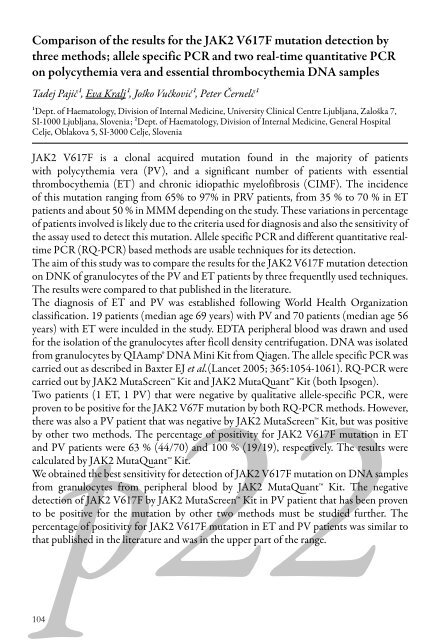You also want an ePaper? Increase the reach of your titles
YUMPU automatically turns print PDFs into web optimized ePapers that Google loves.
Comparison <strong>of</strong> the results for the JAK2 V617F mutation detection by<br />
three methods; allele specific PCR and two real-time quantitative PCR<br />
on polycythemia vera and essential thrombocythemia DNA samples<br />
Tadej Pajič1, Eva Kralj1, Joško Vučković1, Peter Černelč1<br />
1Dept. <strong>of</strong> Haematology, Division <strong>of</strong> Internal Medicine, University Clinical Centre Ljubljana, Zaloška 7,<br />
SI-1000 Ljubljana, Slovenia; 2Dept. <strong>of</strong> Haematology, Division <strong>of</strong> Internal Medicine, General Hospital<br />
Celje, Oblakova 5, SI-3000 Celje, Slovenia<br />
JAK2 V617F is a clonal acquired mutation found in the majority <strong>of</strong> patients<br />
with polycythemia vera (PV), and a significant number <strong>of</strong> patients with essential<br />
thrombocythemia (ET) and chronic idiopathic myel<strong>of</strong>ibrosis (CIMF). The incidence<br />
<strong>of</strong> this mutation ranging from 65% to 97% in PRV patients, from 35 % to 70 % in ET<br />
patients and about 50 % in MMM depending on the study. These variations in percentage<br />
<strong>of</strong> patients involved is likely due to the criteria used for diagnosis and also the sensitivity <strong>of</strong><br />
the assay used to detect this mutation. Allele specific PCR and different quantitative realtime<br />
PCR (RQ-PCR) based methods are usable techniques for its detection.<br />
The aim <strong>of</strong> this study was to compare the results for the JAK2 V617F mutation detection<br />
on DNK <strong>of</strong> granulocytes <strong>of</strong> the PV and ET patients by three frequentlly used techniques.<br />
The results were compared to that published in the literature.<br />
The diagnosis <strong>of</strong> ET and PV was established following World Health Organization<br />
classification. 19 patients (median age 69 years) with PV and 70 patients (median age 56<br />
years) with ET were inculded in the study. EDTA peripheral blood was drawn and used<br />
for the isolation <strong>of</strong> the granulocytes after ficoll density centrifugation. DNA was isolated<br />
from granulocytes by QIAamp® DNA Mini Kit from Qiagen. The allele specific PCR was<br />
carried out as described in Baxter EJ et al.(Lancet 2005; 365:1054-1061). RQ-PCR were<br />
carried out by JAK2 MutaScreen Kit and JAK2 MutaQuant Kit (both Ipsogen).<br />
Two<br />
p22<br />
patients (1 ET, 1 PV) that were negative by qualitative allele-specific PCR, were<br />
proven to be positive for the JAK2 V67F mutation by both RQ-PCR methods. However,<br />
there was also a PV patient that was negative by JAK2 MutaScreen Kit, but was positive<br />
by other two methods. The percentage <strong>of</strong> positivity for JAK2 V617F mutation in ET<br />
and PV patients were 63 % (44/70) and 100 % (19/19), respectively. The results were<br />
calculated by JAK2 MutaQuant Kit.<br />
We obtained the best sensitivity for detection <strong>of</strong> JAK2 V617F mutation on DNA samples<br />
from granulocytes from peripheral blood by JAK2 MutaQuant Kit. The negative<br />
detection <strong>of</strong> JAK2 V617F by JAK2 MutaScreen Kit in PV patient that has been proven<br />
to be positive for the mutation by other two methods must be studied further. The<br />
percentage <strong>of</strong> positivity for JAK2 V617F mutation in ET and PV patients was similar to<br />
that published in the literature and was in the upper part <strong>of</strong> the range.<br />
104
















